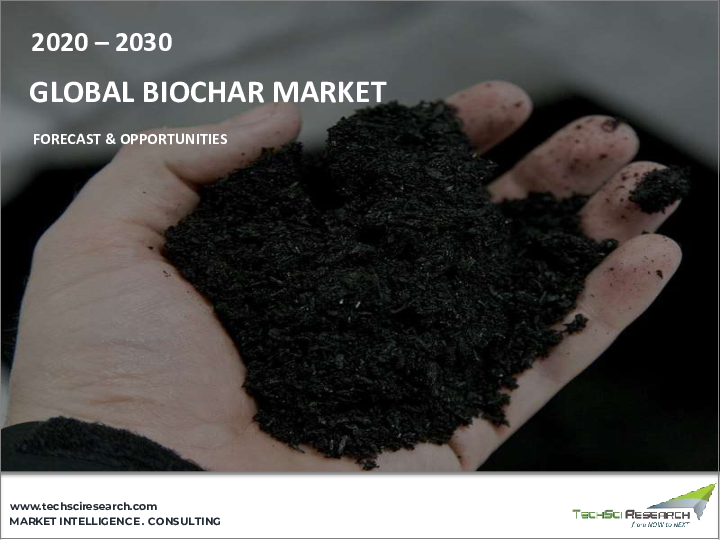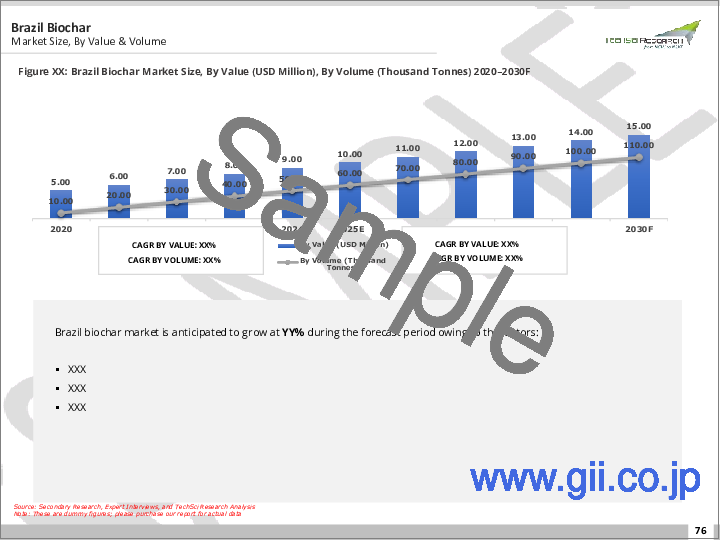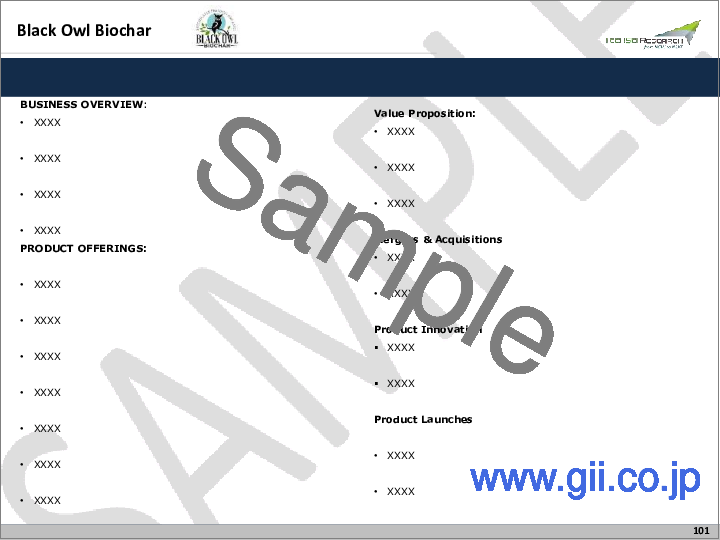|
|
市場調査レポート
商品コード
1797166
バイオ炭市場 - 世界の産業規模、シェア、動向、機会、予測:技術別、用途別、地域別、競合別、2020~2030年Biochar Market - Global Industry Size, Share, Trends, Opportunity & Forecast, Segmented By Technology (Pyrolysis, Gasification, Others), By Application (Agricultural, Industrial, Others), By Region & Competition, 2020-2030F |
||||||
カスタマイズ可能
|
|||||||
| バイオ炭市場 - 世界の産業規模、シェア、動向、機会、予測:技術別、用途別、地域別、競合別、2020~2030年 |
|
出版日: 2025年08月25日
発行: TechSci Research
ページ情報: 英文 180 Pages
納期: 2~3営業日
|
全表示
- 概要
- 目次
世界のバイオ炭の市場規模は2024年に5億745万米ドルで、2030年にはCAGR 5.45%で、6億9,774万米ドルに達すると予測されています。
バイオ炭の世界市場は、農業、産業用途、環境管理など、気候変動に対応した資源効率の高いソリューションへの需要の高まりに後押しされ、持続的かつ加速的な成長を遂げています。バイオ炭は、低酸素環境下での有機バイオマスの熱分解によって生産される安定した炭素密度の高い材料であり、農業、経済、環境面で魅力的な利益をもたらす戦略的材料として浮上しています。
| 市場概要 | |
|---|---|
| 予測期間 | 2026~2030年 |
| 市場規模:2024年 | 5億745万米ドル |
| 市場規模:2030年 | 6億9,774万米ドル |
| CAGR:2025~2030年 | 5.45% |
| 急成長セグメント | 熱分解 |
| 最大市場 | アジア太平洋 |
市場の拡大は、商業化の強力なパイプライン、良好な規制の勢い、使用事例の広がりによって支えられています。農業が引き続き主要な需要の中心である一方、バイオ炭は、グリーン建設資材、廃水ろ過、家畜栄養、炭素除去技術などの高成長産業分野で急速に台頭しています。こうした用途の多様化により、新たな収益経路が生まれ、市場の回復力が強化されつつあります。
カーボンニュートラル、再生農業、循環型経済への世界の注目が高まる中、バイオ炭産業は長期的な持続的成長を遂げる位置にあります。その潜在能力を最大限に発揮するには、技術革新への継続的な投資、世界基準の調和、エネルギー、農業、気候変動資金などのセクター間の統合の強化が不可欠です。
市場促進要因
農業分野におけるバイオ炭需要の高まり
主な市場課題
バイオ炭の特性に関する認識・教育の欠如
主な市場動向
持続可能な農業革命
目次
第1章 概要
第2章 調査手法
第3章 エグゼクティブサマリー
第4章 顧客の声
第5章 世界のバイオ炭市場展望
- 市場規模・予測
- 金額別
- 市場シェア・予測
- 技術別(熱分解、ガス化、その他)
- 用途別(農業、産業、その他)
- 地域別
- 企業別(2024年)
- 市場マップ
第6章 北米のバイオ炭市場展望
- 市場規模・予測
- 市場シェア・予測
- 北米:国別分析
- 米国
- カナダ
- メキシコ
第7章 欧州のバイオ炭市場展望
- 市場規模・予測
- 市場シェア・予測
- 欧州:国別分析
- ドイツ
- 英国
- イタリア
- フランス
- スペイン
第8章 アジア太平洋地域のバイオ炭市場展望
- 市場規模・予測
- 市場シェア・予測
- アジア太平洋地域:国別分析
- 中国
- インド
- 日本
- 韓国
- オーストラリア
第9章 南米のバイオ炭市場展望
- 市場規模・予測
- 市場シェア・予測
- 南米:国別分析
- ブラジル
- アルゼンチン
- コロンビア
第10章 中東・アフリカのバイオ炭市場展望
- 市場規模・予測
- 市場シェア・予測
- 中東・アフリカ:国別分析
- 南アフリカ
- サウジアラビア
- アラブ首長国連邦
第11章 市場力学
- 促進要因
- 課題
第12章 市場動向と発展
- 最近の動向
- 製品上市
- 合併と買収
第13章 世界のバイオ炭市場:SWOT分析
第14章 競合情勢
- Biochar Solutions Inc.
- Black Owl Biochar
- ArSta Eco Pvt Ltd
- Carbon Gold Ltd
- Airex Energy Inc.
- Pacific Biochar Benefit Corporation
- Swiss Biochar GmbH
- Sonnenerde GmbH
- Novocarbo GmbH
- Green Man Char
第15章 戦略的提言
第16章 調査会社について・免責事項
Global Biochar market was valued at USD 507.45 Million in 2024 and is expected to reach USD 697.74 Million by 2030 with a CAGR of 5.45%. The Global Biochar Market is undergoing sustained and accelerated growth, fueled by the increasing demand for climate-smart and resource-efficient solutions across agriculture, industrial applications, and environmental management. Biochar a stable, carbon-dense material produced via pyrolysis of organic biomass in low-oxygen environments has emerged as a strategic material with compelling agronomic, economic, and environmental benefits.
| Market Overview | |
|---|---|
| Forecast Period | 2026-2030 |
| Market Size 2024 | USD 507.45 Million |
| Market Size 2030 | USD 697.74 Million |
| CAGR 2025-2030 | 5.45% |
| Fastest Growing Segment | Pyrolysis |
| Largest Market | Asia-Pacific |
Market expansion is supported by a strong pipeline of commercialization efforts, favorable regulatory momentum, and a widening range of use cases. While agriculture continues to be the primary demand center, biochar is rapidly gaining ground in high-growth industrial segments such as green construction materials, wastewater filtration, livestock nutrition, and carbon removal technologies. These diversified applications are helping to create new revenue pathways and strengthen market resilience.
Amid intensifying global focus on carbon neutrality, regenerative agriculture, and circular economy practices, the biochar industry is positioned for sustained long-term growth. Realizing its full potential will depend on continued investment in technology innovation, harmonization of global standards, and greater integration between sectors including energy, agriculture, and climate finance.
Key Market Drivers
Rising Demand of Biochar in Agricultural Sector
The rising demand for biochar in the agricultural sector is a primary force accelerating the growth of the Global Biochar Market, driven by the need for sustainable farming solutions, soil rejuvenation, and climate-smart practices. A new peer-reviewed study published in Biochar and commissioned by the International Biochar Initiative (IBI) highlights the significant role biochar can play in large-scale carbon removal and climate mitigation. The research provides the first country-level quantification of biochar's carbon dioxide removal (CDR) potential across 155 nations, based solely on sustainably sourced residual biomass not purpose-grown feedstock. The findings confirm that biochar, an age-old agricultural practice, offers a scalable pathway for nations to decarbonize while simultaneously adapting to climate impacts, with the added benefit of unlocking economic and social value through improved soil health, waste management, and rural development. Biochar enhances the physical and chemical properties of soil. Its porous structure improves water retention, aeration, and microbial activity, while its high carbon content enhances nutrient retention and reduces leaching. This leads to better root development and higher crop yields, making biochar an increasingly valuable input for both subsistence and commercial farming operations. The growing need for yield optimization, especially in resource-constrained regions, is driving widespread adoption.
Years of intensive farming, overuse of chemical fertilizers, and monoculture practices have led to widespread soil exhaustion. Biochar offers a biological alternative to chemical fertilizers, restoring soil structure, pH balance, and organic matter. As awareness increases about the long-term risks of synthetic inputs, farmers are shifting toward biochar as a regenerative amendment to restore long-term soil health. With global demand for organic produce and sustainably sourced food on the rise, biochar is being recognized as a natural, non-toxic, and eco-friendly input. It aligns with organic farming regulations and is frequently used in regenerative agriculture systems to rebuild soil carbon, promote biodiversity, and support closed-loop nutrient cycles. This trend is particularly strong in North America and Europe, where consumers and regulators are increasingly focused on environmental certifications and traceability. Biochar's ability to lock carbon in the soil for centuries positions it as a powerful tool in climate-smart agriculture. Governments and carbon markets are offering incentives for practices that reduce greenhouse gas emissions, and biochar is being integrated into carbon credit systems. Agricultural stakeholders adopting biochar can now benefit from dual returns increased crop performance and access to carbon revenue streams making it an economically viable choice.
Key Market Challenges
Lack of Awareness and Education and Variability in Biochar Properties
One of the primary challenges in the biochar market is the lack of awareness and understanding among various stakeholders, including farmers, policymakers, and consumers. Many individuals are unfamiliar with the benefits and applications of biochar, leading to hesitance in its adoption. Raising awareness through educational campaigns, workshops, and seminars is essential to help stakeholders recognize the potential of biochar in improving soil health, carbon sequestration, and waste management, ultimately impacting market growth in the forecast period.
Moreover, biochar properties can vary significantly based on feedstock, pyrolysis conditions, and post-processing techniques. This variability poses challenges in standardizing biochar quality and ensuring consistent performance across different applications. Developing quality standards and certification processes for biochar products can help address this challenge and build trust among end-users restrain the market growth.
Key Market Trends
Sustainable Agriculture Revolution
One of the most prominent trends in the biochar market is its integration into sustainable agricultural practices. Biochar is known to enhance soil structure, water retention, and nutrient availability, thereby leading to improved crop yields and food security. Its ability to mitigate soil degradation, reduce greenhouse gas emissions, and enhance soil carbon storage aligns perfectly with the goals of sustainable agriculture. Farmers worldwide are increasingly recognizing the benefits of incorporating biochar into their farming techniques, and this trend is expected to continue growing as the demand for organic and sustainable produce rises.
Moreover, the escalating concerns about climate change have pushed governments, organizations, and individuals to seek innovative ways to reduce carbon emissions. Biochar offers a unique solution by effectively sequestering carbon from biomass waste that would otherwise decompose and release greenhouse gases into the atmosphere. The stable carbon structure of biochar allows for long-term carbon storage in soils, making it an important tool for climate change mitigation strategies. As nations strive to meet their carbon reduction commitments under international agreements, biochar adoption is likely to play a significant role in achieving those goals. These factors are anticipated to drive the growth of the global Biochar market during the forecast period.
Key Market Players
- Biochar Solutions Inc.
- Black Owl Biochar
- ArSta Eco Pvt Ltd
- Carbon Gold Ltd
- Airex Energy Inc.
- Pacific Biochar Benefit Corporation
- Swiss Biochar GmbH
- Sonnenerde GmbH
- Novocarbo GmbH
- Green Man Char
Report Scope:
In this report, the Global Biochar Market has been segmented into the following categories, in addition to the industry trends which have also been detailed below:
Biochar Market, By Technology:
- Pyrolysis
- Gasification
- Others
Biochar Market, By Application:
- Agricultural
- Industrial
- Others
Biochar Market, By Region:
- North America
- United States
- Canada
- Mexico
- Europe
- France
- Germany
- United Kingdom
- Italy
- Spain
- Asia-Pacific
- China
- India
- South Korea
- Japan
- Australia
- South America
- Brazil
- Argentina
- Colombia
- Middle East & Africa
- South Africa
- Saudi Arabia
- UAE
Competitive Landscape
Company Profiles: Detailed analysis of the major companies present in the Global Biochar Market.
Available Customizations:
Global Biochar Market report with the given market data, TechSci Research offers customizations according to a company's specific needs. The following customization options are available for the report:
Company Information
- Detailed analysis and profiling of additional market players (up to five).
Table of Contents
1. Product Overview
- 1.1. Market Definition
- 1.2. Scope of the Market
- 1.2.1. Markets Covered
- 1.2.2. Years Considered for Study
- 1.2.3. Key Market Segmentations
2. Research Methodology
- 2.1. Objective of the Study
- 2.2. Baseline Methodology
- 2.3. Key Industry Partners
- 2.4. Major Association and Secondary Sources
- 2.5. Forecasting Methodology
- 2.6. Data Triangulation & Validation
- 2.7. Assumptions and Limitations
3. Executive Summary
- 3.1. Overview of the Market
- 3.2. Overview of Key Market Segmentations
- 3.3. Overview of Key Market Players
- 3.4. Overview of Key Regions/Countries
- 3.5. Overview of Market Drivers, Challenges, Trends
4. Voice of Customer
5. Biochar Market Outlook
- 5.1. Market Size & Forecast
- 5.1.1. By Value
- 5.2. Market Share & Forecast
- 5.2.1. By Technology (Pyrolysis, Gasification, Others)
- 5.2.2. By Application (Agricultural, Industrial, Others)
- 5.2.3. By Region
- 5.2.4. By Company (2024)
- 5.3. Market Map
6. North America Biochar Market Outlook
- 6.1. Market Size & Forecast
- 6.1.1. By Value
- 6.2. Market Share & Forecast
- 6.2.1. By Technology
- 6.2.2. By Application
- 6.2.3. By Country
- 6.3. North America: Country Analysis
- 6.3.1. United States Biochar Market Outlook
- 6.3.1.1. Market Size & Forecast
- 6.3.1.1.1. By Value
- 6.3.1.2. Market Share & Forecast
- 6.3.1.2.1. By Technology
- 6.3.1.2.2. By Application
- 6.3.1.1. Market Size & Forecast
- 6.3.2. Canada Biochar Market Outlook
- 6.3.2.1. Market Size & Forecast
- 6.3.2.1.1. By Value
- 6.3.2.2. Market Share & Forecast
- 6.3.2.2.1. By Technology
- 6.3.2.2.2. By Application
- 6.3.2.1. Market Size & Forecast
- 6.3.3. Mexico Biochar Market Outlook
- 6.3.3.1. Market Size & Forecast
- 6.3.3.1.1. By Value
- 6.3.3.2. Market Share & Forecast
- 6.3.3.2.1. By Technology
- 6.3.3.2.2. By Application
- 6.3.3.1. Market Size & Forecast
- 6.3.1. United States Biochar Market Outlook
7. Europe Biochar Market Outlook
- 7.1. Market Size & Forecast
- 7.1.1. By Value
- 7.2. Market Share & Forecast
- 7.2.1. By Technology
- 7.2.2. By Application
- 7.2.3. By Country
- 7.3. Europe: Country Analysis
- 7.3.1. Germany Biochar Market Outlook
- 7.3.1.1. Market Size & Forecast
- 7.3.1.1.1. By Value
- 7.3.1.2. Market Share & Forecast
- 7.3.1.2.1. By Technology
- 7.3.1.2.2. By Application
- 7.3.1.1. Market Size & Forecast
- 7.3.2. United Kingdom Biochar Market Outlook
- 7.3.2.1. Market Size & Forecast
- 7.3.2.1.1. By Value
- 7.3.2.2. Market Share & Forecast
- 7.3.2.2.1. By Technology
- 7.3.2.2.2. By Application
- 7.3.2.1. Market Size & Forecast
- 7.3.3. Italy Biochar Market Outlook
- 7.3.3.1. Market Size & Forecast
- 7.3.3.1.1. By Value
- 7.3.3.2. Market Share & Forecast
- 7.3.3.2.1. By Technology
- 7.3.3.2.2. By Application
- 7.3.3.1. Market Size & Forecast
- 7.3.4. France Biochar Market Outlook
- 7.3.4.1. Market Size & Forecast
- 7.3.4.1.1. By Value
- 7.3.4.2. Market Share & Forecast
- 7.3.4.2.1. By Technology
- 7.3.4.2.2. By Application
- 7.3.4.1. Market Size & Forecast
- 7.3.5. Spain Biochar Market Outlook
- 7.3.5.1. Market Size & Forecast
- 7.3.5.1.1. By Value
- 7.3.5.2. Market Share & Forecast
- 7.3.5.2.1. By Technology
- 7.3.5.2.2. By Application
- 7.3.5.1. Market Size & Forecast
- 7.3.1. Germany Biochar Market Outlook
8. Asia-Pacific Biochar Market Outlook
- 8.1. Market Size & Forecast
- 8.1.1. By Value
- 8.2. Market Share & Forecast
- 8.2.1. By Technology
- 8.2.2. By Application
- 8.2.3. By Country
- 8.3. Asia-Pacific: Country Analysis
- 8.3.1. China Biochar Market Outlook
- 8.3.1.1. Market Size & Forecast
- 8.3.1.1.1. By Value
- 8.3.1.2. Market Share & Forecast
- 8.3.1.2.1. By Technology
- 8.3.1.2.2. By Application
- 8.3.1.1. Market Size & Forecast
- 8.3.2. India Biochar Market Outlook
- 8.3.2.1. Market Size & Forecast
- 8.3.2.1.1. By Value
- 8.3.2.2. Market Share & Forecast
- 8.3.2.2.1. By Technology
- 8.3.2.2.2. By Application
- 8.3.2.1. Market Size & Forecast
- 8.3.3. Japan Biochar Market Outlook
- 8.3.3.1. Market Size & Forecast
- 8.3.3.1.1. By Value
- 8.3.3.2. Market Share & Forecast
- 8.3.3.2.1. By Technology
- 8.3.3.2.2. By Application
- 8.3.3.1. Market Size & Forecast
- 8.3.4. South Korea Biochar Market Outlook
- 8.3.4.1. Market Size & Forecast
- 8.3.4.1.1. By Value
- 8.3.4.2. Market Share & Forecast
- 8.3.4.2.1. By Technology
- 8.3.4.2.2. By Application
- 8.3.4.1. Market Size & Forecast
- 8.3.5. Australia Biochar Market Outlook
- 8.3.5.1. Market Size & Forecast
- 8.3.5.1.1. By Value
- 8.3.5.2. Market Share & Forecast
- 8.3.5.2.1. By Technology
- 8.3.5.2.2. By Application
- 8.3.5.1. Market Size & Forecast
- 8.3.1. China Biochar Market Outlook
9. South America Biochar Market Outlook
- 9.1. Market Size & Forecast
- 9.1.1. By Value
- 9.2. Market Share & Forecast
- 9.2.1. By Technology
- 9.2.2. By Application
- 9.2.3. By Country
- 9.3. South America: Country Analysis
- 9.3.1. Brazil Biochar Market Outlook
- 9.3.1.1. Market Size & Forecast
- 9.3.1.1.1. By Value
- 9.3.1.2. Market Share & Forecast
- 9.3.1.2.1. By Technology
- 9.3.1.2.2. By Application
- 9.3.1.1. Market Size & Forecast
- 9.3.2. Argentina Biochar Market Outlook
- 9.3.2.1. Market Size & Forecast
- 9.3.2.1.1. By Value
- 9.3.2.2. Market Share & Forecast
- 9.3.2.2.1. By Technology
- 9.3.2.2.2. By Application
- 9.3.2.1. Market Size & Forecast
- 9.3.3. Colombia Biochar Market Outlook
- 9.3.3.1. Market Size & Forecast
- 9.3.3.1.1. By Value
- 9.3.3.2. Market Share & Forecast
- 9.3.3.2.1. By Technology
- 9.3.3.2.2. By Application
- 9.3.3.1. Market Size & Forecast
- 9.3.1. Brazil Biochar Market Outlook
10. Middle East and Africa Biochar Market Outlook
- 10.1. Market Size & Forecast
- 10.1.1. By Value
- 10.2. Market Share & Forecast
- 10.2.1. By Technology
- 10.2.2. By Application
- 10.2.3. By Country
- 10.3. MEA: Country Analysis
- 10.3.1. South Africa Biochar Market Outlook
- 10.3.1.1. Market Size & Forecast
- 10.3.1.1.1. By Value
- 10.3.1.2. Market Share & Forecast
- 10.3.1.2.1. By Technology
- 10.3.1.2.2. By Application
- 10.3.1.1. Market Size & Forecast
- 10.3.2. Saudi Arabia Biochar Market Outlook
- 10.3.2.1. Market Size & Forecast
- 10.3.2.1.1. By Value
- 10.3.2.2. Market Share & Forecast
- 10.3.2.2.1. By Technology
- 10.3.2.2.2. By Application
- 10.3.2.1. Market Size & Forecast
- 10.3.3. UAE Biochar Market Outlook
- 10.3.3.1. Market Size & Forecast
- 10.3.3.1.1. By Value
- 10.3.3.2. Market Share & Forecast
- 10.3.3.2.1. By Technology
- 10.3.3.2.2. By Application
- 10.3.3.1. Market Size & Forecast
- 10.3.1. South Africa Biochar Market Outlook
11. Market Dynamics
- 11.1. Drivers
- 11.2. Challenges
12. Market Trends & Developments
- 12.1. Recent Developments
- 12.2. Product Launches
- 12.3. Mergers & Acquisitions
13. Global Biochar Market: SWOT Analysis
14. Competitive Landscape
- 14.1. Biochar Solutions Inc.
- 14.1.1. Business Overview
- 14.1.2. Product & Service Offerings
- 14.1.3. Recent Developments
- 14.1.4. Financials (If Listed)
- 14.1.5. Key Personnel
- 14.1.6. SWOT Analysis
- 14.2. Black Owl Biochar
- 14.3. ArSta Eco Pvt Ltd
- 14.4. Carbon Gold Ltd
- 14.5. Airex Energy Inc.
- 14.6. Pacific Biochar Benefit Corporation
- 14.7. Swiss Biochar GmbH
- 14.8. Sonnenerde GmbH
- 14.9. Novocarbo GmbH
- 14.10.Green Man Char





